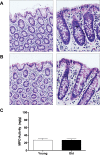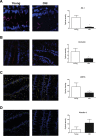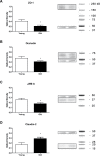Age-associated remodeling of the intestinal epithelial barrier
- PMID: 23873964
- PMCID: PMC3738030
- DOI: 10.1093/gerona/glt106
Age-associated remodeling of the intestinal epithelial barrier
Abstract
Disorders of the gastrointestinal tract are common in the elderly people; however, the precise trait(s) of aging that contribute to the vulnerability of the gastrointestinal tract are poorly understood. Recent evidence suggests that patients with gastrointestinal disorders have increased intestinal permeability. Here, we address the hypothesis that disruption of the intestinal barrier is associated with aging. Our results demonstrated that permeability was significantly higher in colonic biopsies collected from old baboons compared with young baboons. Additionally, colonic tissue from the older animals had decreased zonula occluden-1, occludin, and junctional adhesion molecule-A tight junction protein expression and increased claudin-2 expression. Upregulation of miR-29a and inflammatory cytokines IFN-γ, IL-6, and IL-1β was also found in colonic biopsies from old baboons relative to young baboons. These results show for the first time that a pivotal contributing factor to geriatric vulnerability to gastrointestinal dysfunction may be increased colonic permeability via age-associated remodeling of intestinal epithelial tight junction proteins.
Keywords: Aging; Cytokines; MicroRNA; Permeability; Tight junctions.
Figures






Similar articles
-
Effect of toll-like receptor 3 agonist poly I:C on intestinal mucosa and epithelial barrier function in mouse models of acute colitis.World J Gastroenterol. 2017 Feb 14;23(6):999-1009. doi: 10.3748/wjg.v23.i6.999. World J Gastroenterol. 2017. PMID: 28246473 Free PMC article.
-
miR-200b inhibits TNF-α-induced IL-8 secretion and tight junction disruption of intestinal epithelial cells in vitro.Am J Physiol Gastrointest Liver Physiol. 2017 Feb 1;312(2):G123-G132. doi: 10.1152/ajpgi.00316.2016. Epub 2016 Dec 15. Am J Physiol Gastrointest Liver Physiol. 2017. PMID: 27979826
-
MiR-34c and PlncRNA1 mediated the function of intestinal epithelial barrier by regulating tight junction proteins in inflammatory bowel disease.Biochem Biophys Res Commun. 2017 Apr 22;486(1):6-13. doi: 10.1016/j.bbrc.2017.01.115. Epub 2017 Jan 30. Biochem Biophys Res Commun. 2017. PMID: 28153728
-
Gastrointestinal mucosal barrier function and diseases.J Gastroenterol. 2016 Aug;51(8):768-78. doi: 10.1007/s00535-016-1207-z. Epub 2016 Apr 5. J Gastroenterol. 2016. PMID: 27048502 Review.
-
Development, validation and implementation of an in vitro model for the study of metabolic and immune function in normal and inflamed human colonic epithelium.Dan Med J. 2015 Jan;62(1):B4973. Dan Med J. 2015. PMID: 25557335 Review.
Cited by
-
Probiotics, prebiotics, synbiotics and other microbiome-based innovative therapeutics to mitigate obesity and enhance longevity via the gut-brain axis.Microbiome Res Rep. 2024 May 17;3(3):29. doi: 10.20517/mrr.2024.05. eCollection 2024. Microbiome Res Rep. 2024. PMID: 39421246 Free PMC article. Review.
-
Innate immunity in peripheral tissues is differentially impaired under normal and endotoxic conditions in aging.Front Immunol. 2024 Aug 16;15:1357444. doi: 10.3389/fimmu.2024.1357444. eCollection 2024. Front Immunol. 2024. PMID: 39221237 Free PMC article.
-
Dietary nitrate maintains intestinal epithelia homeostasis in aged mice.Biogerontology. 2024 Nov;25(6):1171-1187. doi: 10.1007/s10522-024-10127-5. Epub 2024 Aug 20. Biogerontology. 2024. PMID: 39162978 Free PMC article.
-
Changes in the gut microbiota of patients with sarcopenia based on 16S rRNA gene sequencing: a systematic review and meta-analysis.Front Nutr. 2024 Jun 28;11:1429242. doi: 10.3389/fnut.2024.1429242. eCollection 2024. Front Nutr. 2024. PMID: 39006102 Free PMC article.
-
Physical frailty, genetic predisposition, and the risks of severe non-alcoholic fatty liver disease and cirrhosis: a cohort study.J Cachexia Sarcopenia Muscle. 2024 Aug;15(4):1491-1500. doi: 10.1002/jcsm.13506. Epub 2024 Jun 18. J Cachexia Sarcopenia Muscle. 2024. PMID: 38887910 Free PMC article.
References
-
- Hall KE, Proctor DD, Fisher L, Rose S. American gastroenterological association future trends committee report: effects of aging of the population on gastroenterology practice, education, and research. Gastroenterology. 2005;129:1305–1338.10.1053/j.gastro.2005.06.013 - PubMed
-
- O’Mahony D, O’Leary P, Quigley EM. Aging and intestinal motility: a review of factors that affect intestinal motility in the aged. Drugs Aging. 2002;19:515–527 - PubMed
-
- Hollander D, Tarnawski H. Aging-associated increase in intestinal absorption of macromolecules. Gerontology. 1985;31:133–137 - PubMed
-
- Katz D, Hollander D, Said HM, Dadufalza V. Aging-associated increase in intestinal permeability to polyethylene glycol 900. Dig Dis Sci. 1987;32:285–288 - PubMed
Publication types
MeSH terms
Substances
Grants and funding
LinkOut - more resources
Full Text Sources
Other Literature Sources
Medical

